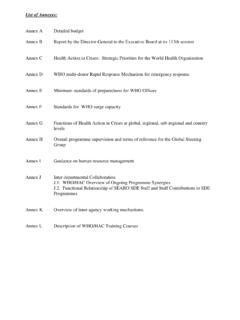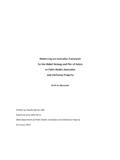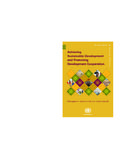Transcription of Africa REGIONAL OVERVIEW OF FOOD SECURITY AND …
1 REGIONAL OVERVIEW OFFOOD SECURITYAND NUTRITION2017 THE FOOD SECURITY AND NUTRITION CONFLICT NEXUS: BUILDING RESILIENCE FOR FOOD SECURITY , NUTRITION AND PEACE AfricaCOVER PHOTOGRAPHA woman and her family planting seeds and seedlings FAO/Giulio NapolitanoFAO information products are available on the FAO website ( ) and can be purchased through publications-salesFood and Agriculture Organization of the United NationsAccra, 2017 REGIONAL OVERVIEW OFFOOD SECURITYAND NUTRITIONTHE FOOD SECURITY AND NUTRITION CONFLICT NEXUS: BUILDING RESILIENCE FOR FOOD SECURITY , NUTRITION AND PEACE Africa2017 REQUIRED CITATION:FAO. 2017. REGIONAL OVERVIEW of Food SECURITY and Nutrition in Africa 2017. The food SECURITY and nutrition conflict nexus: building resilience for food SECURITY , nutrition and peace. designations employed and the presentation of material in this information product do not imply the expression of any opinion whatsoever on the part of the Food and Agriculture Organization of the United Nations (FAO) concerning the legal or development status of any country, territory, city or area or of its authorities, or concerning the delimitation of its frontiers or boundaries.
2 The mention of specific companies or products of manufacturers, whether or not these have been patented, does not imply that these have been endorsed or recommended by FAO in preference to others of a similar nature that are not mentioned. ISBN 978-92-5-109981-0 FAO, 2017 FAO encourages the use, reproduction and dissemination of material in this information product. Except where otherwise indicated, material may be copied, downloaded and printed for private study, research and teaching purposes, or for use in non-commercial products or services, provided that appropriate acknowledgement of FAO as the source and copyright holder is given and that FAO s endorsement of users views, products or services is not implied in any way. All requests for translation and adaptation rights, and for resale and other commercial use rights should be made via or addressed to FAO information products are available on the FAO website ( ) and can be purchased through v ACKNOWLEDGEMENTS viiACRONYMS viiiKEY MESSAGES ix PART 1 REGIONAL OVERVIEW OF FOOD SECURITY AND NUTRITION 1 After a prolonged decline, hunger appears to be on the rise globally 1 The 2030 Sustainable Development Agenda and food SECURITY and nutrition targets 2 Trends in food SECURITY and nutrition in Africa 3 SDG Indicator : Prevalence of undernourishment (PoU) 5 Prevalence of severe food insecurity measured with the Food Insecurity Experience Scale (FIES) 10 The multiple burdens of malnutrition 11 Trends in multiple burdens of malnutrition in Africa 11 SDG Indicator.
3 Prevalence of stunting 11 SDG Indicator : Prevalence of wasting and overweight in children 14 Progress towards the World Health Assembly targets 16 Exclusive breastfeeding 18 Anaemia in women of reproductive age 19 Low birth weight 19 Adult overweight and obesity 20 Progress has slowed, new concerns have emerged 21 PART 2 POLICIES AND PROGRAMMES TO SUPPORT FOOD SECURITY AND NUTRITION 24 The recent REGIONAL experience 25 The Malabo Declaration 26 REGIONAL and national policies, strategies and plans to promote food SECURITY and nutrition 28 REGIONAL and national policies for food SECURITY and improved nutrition outcomes reflect a broad, multidisciplinary approach 29 Raising agricultural production and productivity is essential for adequate food availability 30 Agricultural production and productivity and social protection essential to improve access to food. 37 Stability of availability and access to food also important in ensuring food SECURITY 42 Food utilization also determines nutrition outcomes 43 Policies and programmes are aligned with the Malabo Declaration and achieving SDG 2 47 PART 3 CONFLICT, FOOD SECURITY AND NUTRITION 49 How does conflict affect food SECURITY and nutrition 52 Conflict and food SECURITY : some recent evidence 52 Can food insecurity and undernutrition trigger conflict?
4 53 Case study: Lake Chad crisis 54 International response mechanism 56 REGIONAL response mechanism 56 National response mechanism 58 Building resilience for food SECURITY and peace 58 ANNEX 63 REGIONAL and subregional policies and programmes 63 National policies and programmes 65iiiREFERENCES 89 Table 1: Undernourishment in sub-Saharan Africa and subregions, 2000 2016 Table 2: Undernourishment in Western Africa , 2000 2016 Table 3: Undernourishment in Middle Africa , 2000 2016 Table 4: Undernourishment in Eastern Africa , 2000 2016 Table 5: Undernourishment in Southern Africa , 2000 2016 Table 6: Prevalence of severe food insecurity (measured using the FIES) in the world and in sub-Saharan Africa , 2014 2016 Table 7: Level and growth in Dietary Energy Supply AdequacyTable 8: Number of countries with different proportions of land equipped for irrigationFigure 1: Prevalence of undernourishment in sub-Saharan Africa and subregions, in 2000 2016 Figure 2: Number of undernourished people in sub-Saharan Africa and subregions in 2000 2016 Figure 3: Proportion of stunted children under five by subregion in 2000 2015 Figure 4: Proportion of stunted children under five by countriesBox 1: The Prevalence of Undernourishment and the Food Insecurity Experience Scale Box 2: Ghana, food SECURITY success story Box 3: ReSAKSS: support to evidence-based decision-making Box 4: Climate change and civil conflict Box 5: Options for livelihood support for fishermen in northeast NigeriaTABLES, FIGURES AND BOXESTABLEFIGURESBOXESF igure 5: Prevalence of wasted children under five by subregion in 2015 Figure 6: Prevalence of overweight children under five by subregion in 2000 2015 Figure 7.
5 Number of countries in each subregion and number of WHA targets they are on track for Figure 8: Proportion of countries in each subregion that are on track to meet the WHA targets Figure 9: Prevalence of exclusive breastfeeding in the first three months Figure 10: Prevalence of anaemia in women of reproductive age in sub-Saharan Africa in 2005 and 2015 Figure 11: Prevalence of adult obesity in sub-Saharan Africa in 2005 and 2014 Figure 12: Prevalence of adult male and female obesity in 2014 by subregion Figure 13: Average DESA versus PoU for sub-Saharan African countries (2000 2015) Figure 14: Net per capita food production indices for sub-Saharan Africa by subregion, 2000 2014 Figure 15: Total Factor Productivity indices for sub-Saharan Africa by region, 1981 1990, 1991 2000, 2001 2009 Figure 16: Value of food imports for sub-Saharan Africa by subregion, 2000 2014 Figure 17: Poverty rates for sub-Saharan Africa and subregions, 1990 2013 Figure 18: Real GDP per capita growth for sub-Saharan Africa and subregions, 2009 2014 Figure 19: Domestic food price index for sub-Saharan Africa and subregions, 2000 2013 Figure 20: Prevalence of stunting in children under five versus proportion of calories derived from cereals and roots and tubers out of total calories Figure 21: Access to improved water sources, 2004 2014 Figure 22: Access to improved sanitation facilities, 2004 2014 ivFOREWORDD uring the first decade of the century, sub-Saharan Africa made sound progress in its fight against hunger with the region witnessing a decline in the prevalence and number of undernourished people.
6 However, in 2015 and 2016, there was a reversal of this trend as even the prevalence of undernourished trend reversal was attributable in many countries of the region to adverse climatic conditions, often linked to the El Ni o phenomenon, which resulted in poor harvests and loss of livestock. Lower commodity prices and increasingly challenging global economic conditions, coupled with the outbreak of conflicts at times concurrently with natural calamities such as droughts or floods further exacerbated the food SECURITY and nutrition situation across the the light of these recent developments, it is essential that we step up our efforts if we are to achieve a world without hunger by Africa s vision for development continues to be driven by the African Union s Agenda 2063 as well as the principles enshrined in the Comprehensive Africa Agriculture Development Programme (CAADP). The goal defined in the Agenda 2063, and further reaffirmed in the Malabo Declaration as well as in the Africa REGIONAL Nutrition Strategy 2015 2025 of ending hunger and halving poverty by 2025, is closely aligned with the SDG 2 and the Decade of Action on Nutrition 2016 2025, the framework to implement the commitments taken at the second International Conference on Nutrition and achieve the World Health Assembly depicted in this report, countries in sub-Saharan Africa have been developing policy frameworks and investment plans that should be conducive to the attainment of the goals set in the Malabo Declaration and the SDG 2, in conformity with the process advocated by CAADP of raising the profile of agriculture and reinforcing agricultural report highlights the devastating effects of conflicts on food SECURITY and nutrition in many sub-Saharan African countries.
7 Over one-third of the world's violent conflicts took place in sub-Saharan Africa and the region harbours nearly 70 percent of all conflict-affected countries in protracted in the region have affected primarily rural areas, damaging agriculture and disrupting both food production and food systems. The resulting disruption or destruction of livelihoods constitute a major cause of acute and chronic food insecurity and malnutrition. The magnitude of the adverse impact of conflicts in this respect can be perceived in northeast Nigeria, South Sudan and Somalia, where conflict has led million people to face severe food noteworthy are the findings presented in the report that food insecurity and malnutrition could in turn constitute drivers of the complex interplay of grievances that spawn conflicts. The conflict and food insecurity nexus, which may be further aggravated by the climate change dimension, becomes a critical issue to focus on as we strive to decipher the complexities of the interrelationship between food SECURITY , fragility, conflict and violence in the quest of embedding sustainable development and ultimately achieving the SDG of the fact that mutually reinforcing factors link food insecurity, malnutrition, social and political instability and conflicts has led to the realization of the need to combine efforts across disciplines, supporting resilient livelihoods in conjunction with sustaining peace and conflict resolution, in order to achieve sustainable development as well as food and nutrition SECURITY .
8 Investing in food SECURITY and agriculture thus becomes essential if we are to help prevent conflict and achieve lasting peace. Populations affected by conflicts either as displaced persons or as host communities often require assistance, in terms of food or cash, or basic social services. In attributing greater focus on rebuilding livelihoods which are often linked to agriculture, it is important to underscore the significance of investments in infrastructure, such as irrigation, and in social protection systems so as to sustain households in times of need, thereby curbing the need to rely on destructive coping strategies and securing strengthened resilience of sub-Saharan African countries to the shocks of man-made disasters. I trust that this report provides member countries the requisite information and insights that enable them to work effectively towards achieving the Malabo Declaration and the SDG 2. Its contents and findings are presented with the aim of providing a fresh perspective and renewed impetus towards building a peaceful and resilient continent through the pursuit of a coherent and multifaceted approach to strengthen livelihoods in agriculture, fisheries and Tijani Assistant Director-General andRegional Representative for AfricaThis third edition of the REGIONAL OVERVIEW of Food SECURITY and Nutrition in Africa has been prepared by the FAO REGIONAL Office for Africa (RAF) in close cooperation with the Agricultural Development Economics Division (ESA), the Statistics Division (ESS) and the Nutrition and Food Systems Division (ESN) in FAO Croppenstedt (Policy Officer)
9 Coordinated the preparation of the document and led its production under the overall supervision and guidance of Bukar Tijani, Assistant Director-General and REGIONAL Representative for Africa , assisted by Serge Nakouzi, Deputy REGIONAL Representative for Africa , and by Abebe Haile-Gabriel, REGIONAL Programme Leader for Africa and FAO Representative to the overall supervision of Kostas Stamoulis, FAO Assistant Director-General for the Economic and Social Development Department, the coordination and technical support provided by the Agricultural Development Economics Division (ESA) was led by Rob Vos, ESA Director, Cindy Holleman and Areej Jafari. Valuable contributions for Part Two were received from the Food and Agriculture Policy Decision Analysis (FAPDA) team of ESA Division, including Ekaterina Dorodnykh, Eugenia Stefanelli, and Luca Renzi. Data for Part One were provided by the FAO Statistics Division led by Jos Rosero Moncayo, Deputy Director ESS, and the Food SECURITY and Nutrition Statistics Team led by Carlo Cafiero, including particularly Filippo Gheri and Anne valuable contributions for Part Two were received from the FAO subregional offices for Southern Africa and Central Africa ; and the FAO country offices in Burkina Faso, Cabo Verde, Chad, Guinea, Kenya, Mozambique and RAF Resilience team, led by Farayi Zimudzi and including Jacques Conforti, Abeshaw Gebru and Louise Tine, as well as Patrick David from FAO Senegal, made substantial contributions to Part Three.
10 Martin Van der Knaap, RAF Fisheries Officer, also contributed material to Part report benefited from several rounds of reviews by colleagues in the Economics and Social Development Department mentioned above, and Diana Carter, Ellen Andresen and Marco Knowles. Furthermore, the report was reviewed by Serge Nakouzi, Abebe Haile-Gabriel, Koffi Amegbeto, Berhanu Bedane, Joas Fiodehoume, Liliane Kambirigi, Igor Vinci and Mawuli Sablah from FAO REGIONAL Office fo















